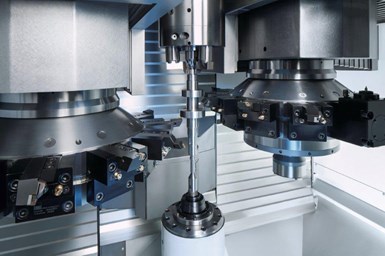Emag VT 4-Axes Lathes for Shaft Production Maximum Performance
IMTS 2022: The lathes are said to provide short cycle times, high-precision machining and safe processing with the VT series of turning machines literally turning the classic horizontal machining process on its head.

The dual tool turrets of VT Series lathes, each with 11 stations (all of which can be equipped with turning tools along with driven tools), are said to guarantee flexibility. Photo Credit: EMAG
Manufacturing large quantities of shafts requires fast processes. Emag’s VT 2 and VT 4 lathes are said to provide not only precise and efficient machining, but their integrated loading and unloading systems also deliver optimum speed and performance. With short cycle times, high-precision machining and safe processing, the turning machines of the VT series are said to literally turn the classic horizontal machining process on its head.
In addition to employing four axes, short travels and a powerful main spindle, these modular lathes are twin-sided, enabling large batch components to be manufactured quickly. The dual tool turrets — each with 11 stations, all of which can be equipped with turning tools along with driven tools — are said to guarantee flexibility. Automation is fully integrated on these lathes. The turret loads and unloads work pieces into the machining area. While one gripper, occupying the twelfth position of the turret, conveys a new raw part into the machine, the other removes the finished component. The loading process can take as little as six seconds, depending on the workpiece.
The VT 2 can handle workpiece diameters up to 4" (100 mm) and lengths up to 15.5" (400 mm). The VT 4 accepts shafts up to 8" (200 mm) in diameter and up to 25" (630 mm) long.
Some advantages of the VT series include shorter cycle times through four-axes machining, less expense for automation and peripherals, and reduced idle times through cycle time-concurrent loading and unloading, the company says. The machine can be used as a stand-alone or in a production line. Easily accessible and operator-friendly workpiece areas mean short setting and resetting times. And less operator intervention because tailstock and steady are CN-controlled, and turrets can be accessed directly.
The company says the vertical construction of the machine and the resulting free chip flow prevent the creation of chip clusters. Raw part and finished component storage are said to form an integral part of the machine.
Related Content
-
An Automated Answer for Machining Ball Pins
This new vertical turning center with measurement and robotic automation processes is able to produce vehicle ball joint ball pins in 7 seconds.
-
Schaublin 302 Is Compact, High-Precision Lathe for Flexible Production
PMTS 2023: This multipurpose machine is a high-precision production lathe that features a FANUC digital control, compact size and flexibility for cost-effective, small- and large-scale production runs.
-
Boring Head Enables Sculpture Hardware to Be Machined on a Lathe
When small job shop Ansonia Manufacturing took on a tricky hardware component job for a “live” glass art sculpture, it realized a boring head would be needed to machine the part complete on its live-tool lathe.












.jpg;maxWidth=300;quality=90)


